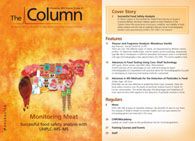The Benefits of Okra
A team of researchers at the University of Huddersfield, UK, has investigated the potential of okra for emulsification of certain food products using size-exclusion chromatography (SEC) and fourier transform infrared (FTIR) spectroscopy.1 Okra is a flowering plant and originates from Africa. Okra pectins are acidic, random coil polysaccharides composed of galactose, rhamnose, and galacturonic acid. Pectins are used in the food industry for their gelling, stabilizing, and thickening properties. Okra pectins differ quite substantially from those extracted from apple, citrus, and beet in terms of protein and acetyl contents, indicating their greater hydrophobicity and suggesting that pectin derived from okra can be used as an effective emulsifying agent.?

Photo Credit: Paul Williams - Funkystock/Getty Images
A team of researchers at the University of Huddersfield, UK, has investigated the potential of okra for emulsification of certain food products using size-exclusion chromatography (SEC) and fourier transform infrared (FTIR) spectroscopy.1 Okra is a flowering plant and originates from Africa. Okra pectins are acidic, random coil polysaccharides composed of galactose, rhamnose, and galacturonic acid. Pectins are used in the food industry for their gelling, stabilizing, and thickening properties. Okra pectins differ quite substantially from those extracted from apple, citrus, and beet in terms of protein and acetyl contents, indicating their greater hydrophobicity and suggesting that pectin derived from okra can be used as an effective emulsifying agent.
Extracts rich in pectins were isolated by aqueous extraction from okra pods. Extracted polysaccharides were assessed using SEC and FTIR spectroscopy. Lead author of the study, Katerina Alba, told The Column: “SEC was performed in order to obtain information with regards to molecular dimensions of isolated pectins. This data contributed to further understanding of the effect of extraction conditions on the physiochemical characteristics of okra polysaccharides, and consequently their potential to act as emulsifying agents.”
The two extracts, OE6 and OE4, both showed good emulsification but differed greatly in terms of their efficiency towards long-term stabilization against coarsening. OE6 emulsions were stable; OE4 were more susceptible to coarsening, which resulted in droplets of greater than average size. The increased stability of the OE6 emulsions was attributed to the higher protein load of the interfaces, resulting in increased rigidity; viscosity was also two times greater than OE4.
Katerina detailed how beneficial this research could be for the food industry and for consumers. She said: “Recently, the nutritional and functional properties of okra pods have re-awakened interest to research its potential uses. There were several studies that have revealed the antioxidant activity of okra flour, whereas okra seeds are also considered as [a] high-protein oilseed crop and can be used as a complement to other pectin sources. Physiological studies have demonstrated hypoglycemic
properties of okra polysaccharides, suggesting their potential use as functional food ingredients. However, the structural analysis and potential of okra isolates to act as a food hydrocolloid in model food matrices have not been reported yet.”
The team concluded that okra extracts are good candidates for emulsification in acidic environments. Katerina concluded: “Future research will involve the evaluation of gelation properties of polysaccharides extracted from okra pods and further exploration of its potential in drug delivery systems.” — K.M.
Reference
1. K. Alba et al., Food Research International 54, 1730–1737 (2013).
This story originally appeared in The Column. Click here to view that issue.

Measuring Vitamin K1 Concentrations in Dogs with Chronic Enteropathy Using LC–MS/MS
May 14th 2025A joint study between the University of Tennessee (Knoxville, Tennessee) and the University of Pennsylvania School of Veterinary Medicine (Philadelphia, Pennsylvania) compared directly measured vitamin K1 (vitK1) concentrations in healthy dogs and dogs with chronic enteropathy (CE) using liquid chromatography tandem mass spectrometry (LC–MS/MS); they also investigated whether supplementation of vitK1 in dogs with CE would significantly increase vitK1 concentrations.
HPLC 2025 Preview: Fundamentally Speaking (Part 2)
May 14th 2025Michael Lämmerhofer from the Institute of Pharmaceutical Sciences, University of Tübingen, Germany, spoke to JFK Huber Lecture Award winner of 2024 Torgny Fornstedt, professor in analytical chemistry and leader of the Fundamental Separation Science Group, Karlstad University, Sweden, about his pioneering work in high performance liquid chromatography (HPLC) with a focus on fundamentals, ion-pair chromatography, and oligonucleotide applications.

.png&w=3840&q=75)

.png&w=3840&q=75)



.png&w=3840&q=75)



.png&w=3840&q=75)










